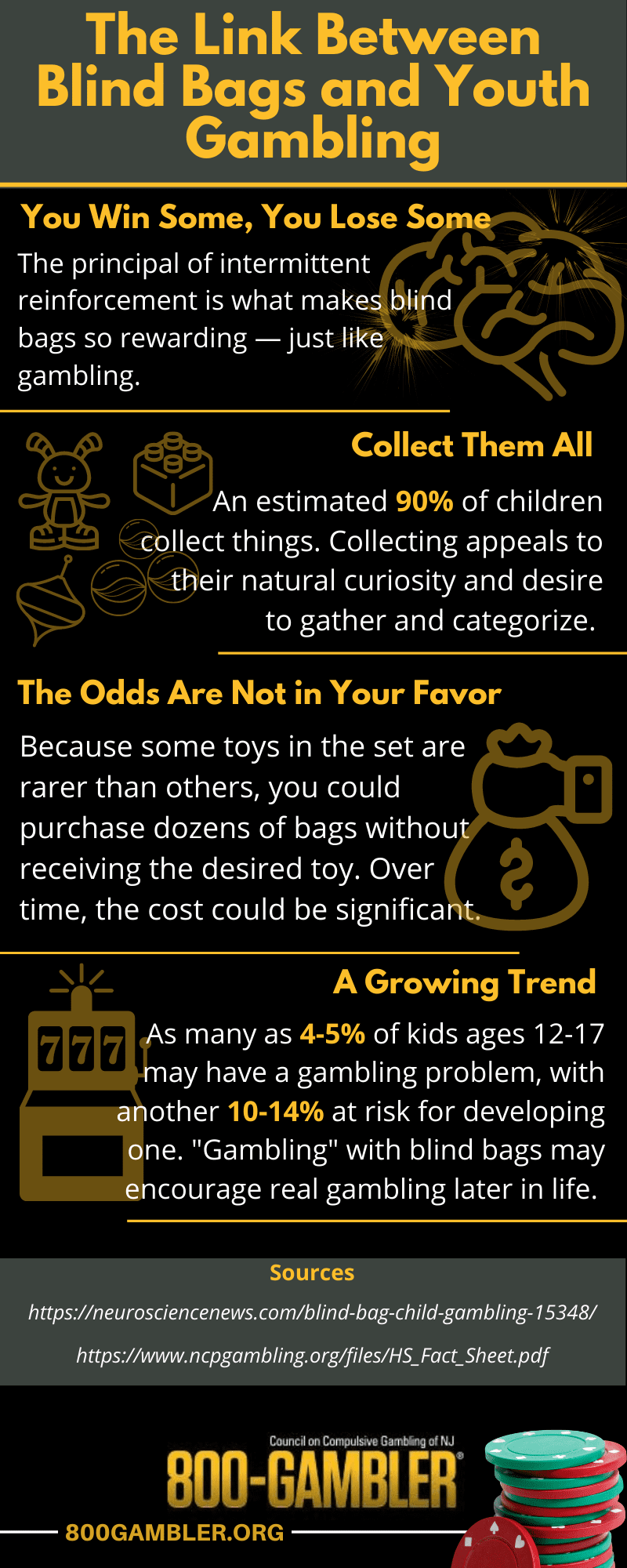If you haven’t been down the toy aisle lately, you might be surprised to find that one of the most popular items is not an action figure, doll, or stuffed animal. The relatively inexpensive item that has captured children’s attention is merely a small bag, box, or capsule that conceals a small collectible toy.
The premise seems innocuous: you open the bag and receive a surprise toy from a set. L.O.L. Surprise! Dolls are some of the most sought-after toys of this variety, but hundreds of these products exist, spanning many popular franchises such as Marvel and My Little Pony. But what happens when the child opens the box and doesn’t get the character they were hoping for?
Some children will continue to purchase more blind bags in pursuit of the item they’re seeking. When they finally score it, the payoff is that much more gratifying. Sound familiar? Some experts are concerned that this trend could be setting up young people for gambling problems in the future.
The Rise of “Unboxing” Popularity
Getting a surprise toy is certainly not a new concept, as anyone who’s ever plunked a quarter into the machine at their local pizzeria can attest. But the process of opening boxes of toys has become a sensation on YouTube, and there are entire channels devoted to children opening blind bags. This “glamorization” further fuels young people’s interest in these toys, increasing their desire to obtain the rarer ones in the set.
As unboxing videos have spurred the popularity of specific collectible toys, sales have skyrocketed, as have the concerns of experts worried about the long-term implications of glamorizing this type of behavior. However, YouTube videos aren’t the only way these types of toys gain outsized popularity.
Gotta Collect Them All
Going back to the Pokémon craze of the mid-90s, children have been drawn to toys and collectibles that encourage them to collect every piece of the set. For Pokémon, it meant collecting all 150 cards even though the scarcity of the higher-level cards made it that much more difficult. This intermittent reward system has evolved in recent years with the introduction of blind boxes.
With a blind box, instead of getting a card pack with a set number of cards inside, children get a set number of small toys to complete their set. With the wording on the packaging encouraging children to “collect them all,” you see more children looking to get more and more packs to reach their goal of having them all.
These small vinyl figures can range in shapes and sizes, but the end goal of collecting them all bears a shocking resemblance to gambling habits in older teenagers and adults.
Why Blind Bags Are So Rewarding to Young Brains
The psychology behind blind bags is much more than just having a toy that children want. The concept is “intermittent reinforcement,” which was demonstrated in experiments with pigeons by American psychologist B.F. Skinner.
In the experiment, the pigeons were trained to use a lever that would dispense food. If the lever gave food every time, the birds would only peck the lever when they were hungry. However, if the lever only delivered food at variable ratios, the pigeons started pecking the lever compulsively. This same concept rewards gamblers — slot machines are a prime example of intermittent reinforcement.
Here are some facts about how gambling behaviors can start young:

The fact that the toys are inexpensive — typically under $10 — makes it easy for parents to say “yes” when their child pleads to have one during a weekly shopping trip.
Intermittent Reinforcement in Children
The fact that the toys are inexpensive — typically under $10 — makes it easy for parents to say “yes” when their child pleads to have one during a weekly shopping trip. While a bling bag may not have a striking resemblance to lottery tickets, the odds of getting the rarer toys in the collection can be quite similar. So when your child does get that rare toy in the blind bag, the intermittent reinforcement kicks in, showing them that persistence can lead to a reward with enough determination and patience.
The potential exists for this intermittent reinforcement to stay with kids as they go into high school and beyond, where access to gambling activities becomes easier to come by. It can potentially lead to the kids developing gambling problems in the form of youth gambling or a propensity towards online gambling.
Beyond the Toy Aisle
Blind bag toys are not the only exposure that people under the age of 18 have to gambling-like practices. Many video games contain “loot boxes” that you can purchase for real money, and they are essentially virtual blind bags containing different in-game items. With more popular video games implementing loot boxes and other microtransactions, game developers are trying to commodify every aspect of their games. This can potentially create a new generation of problem gamblers. We’ve examined the potential dangers that these loot boxes may pose for problem gambling in teenagers.
Talking to Children About Gambling
Even if your child has never asked you to purchase a blind bag for them, they are likely exposed to these collectibles through their friends or classmates. Keeping an open line of communication is essential, and helping children develop healthy attitudes about gambling from a young age can go a long way.
Here are a few tips for talking to children about surprise toys and loot boxes:
We Have Resources for All Ages
Simply because most people associate problem gambling with adults doesn’t mean that your children or teenagers can’t benefit from CCGNJ’s vast array of resources. We have programs, sources, guidance, and more to help parents and their children deal with a potentially developing gambling problem before it gets worse.
As an example of its work to prevent youth gambling, CCGNJ partners with the Lottery to discourage parents and other adults from giving lottery tickets to their underage children — whether high school or younger. The main focus of this prevention program is during the holidays, but it holds true year-round.
If you have noticed unhealthy, gambling-like behaviors in your child or another young person you know, know that there are resources available to help. Call or text our helpline, 1-800-GAMBLER, at any time for support, treatment, and hope.
Sources:
https://neurosciencenews.com/blind-bag-child-gambling-15348/



